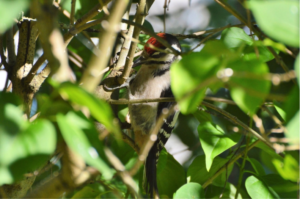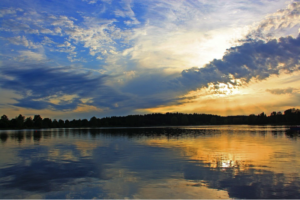
Sitting in a bird hide calms me. Walking down “Green Lane” at my local nature reserve slackens the umbilical cord to my stress and worries for a while.
Its February in the UK. Temperatures hover around freezing. It rains, snows, and the wind blows. And yet, wrapped up well, I am transported to a haven of calmness, and serenity. I am not achieving anything. Time is ticking away… and yet, time stops whilst I am here.
Do I imagine this calmness, or does a natural environment really affect my mood, and cause my body and mind to feel better?
A study from the 1970s caught my eye recently. Robert Ulrich studied the effects of the natural environment adjacent to a hospital in Paoli, Pennsylvania, on a group of gall bladder patients after their routine surgery.
All patients had the same surgery, and all recovered in the same ward; however, some patients needed an extra day, on average, in hospital before being recovered enough to go home. It was also observed that those same patients experienced more pain; required multiple doses of strong pain relief; presented more symptoms of depression; and had around four ‘negative notes’ per person on their record (‘negative notes’ were logged by the nurses and related to the patient’s mood and motivation to get up).
On the records of other patients in the same ward, nurses added only one negative note at most, and these patients required only one dose of heavy painkillers during their stay, which was also generally shorter than the patients documented above.
Ulrich gained the co-operation of the hospital in pairing patients into a controlled study – same age, gender, weight, and smokers/non-smokers were all matched. They retained the same doctors and nurses, so that as far as possible there was little difference between each pair of patients. However, Ulrich engineered one big difference between each in a pair; the view given by their room position.
One side of the hospital faced a brick wall. The other faced a natural environment of trees. Ulrich’s results showed that being in a room with the natural view, generally, resulted in a faster recovery, less experience of pain, and a more positive outlook.

But why might this be so?
As I stroll down Green Lane, further onto the reserve, I note the first indications of Spring in the trees – now quite rapidly changing in appearance each time I visit – I picture the patients in their hospital beds. Some are relaxing as sunlight fills their rooms, and the trees outside their window gently shake in the breeze. Others, on the far side of the building, lie in their beds, no respite from the pain which preoccupies their mind; no comfort to be found in the geometry of the bricks outside their window.
Theorists claim that the way the brain reacts to being in the natural environment, as opposed to the demands of urban everyday life; can go a long way to explain the calming, recharging effect of being in a woodland or birdwatching by an old gravel pit.
William James (1892) claimed that the mind focusses its attention in two different ways – things which grab our attention, which he called “voluntary attention” – noise, tasks we are undertaking, driving, walking in busy places. We must force our brain to focus on these, and they exhaust it.
James theorised that, at other times, we use another way of focussing our attention, on other attractions – which may not be essential, but are more interesting to us. James called this “involuntary attention”; and it was his idea that such stimulation restores us. This environment is restful and refuelling because it doesn’t demand anything of us, apart from that which we are willing to give.
James’ theory was built on the effort of paying attention to something which is not particularly of interest to us (voluntary attention); and to the focus involved in avoiding paying attention to the more pleasurable and restorative.

I have now reached the halfway point on this route through the reserve. I sit in a hide by the Mere, and I can feel this process play out. I have moved from the everyday demands of being an employee, a wife, a carer, and the tasks involved in those roles; to being birdwatcher and stroller-in-the-wilderness – just “being”, and responding passively to stimulus as it flies, floats or walks by.
Kaplan (1995) developed James’ ideas. He placed emphasis on James’ combination of the focus and effort involved in voluntary attention (which Kaplan renamed ‘directed attention’), and developed it to investigate the inhibition used to direct our attention to a task due to its importance; and away from things which are interesting, but not vital at that moment. “…any prolonged mental effort leads to directed attention fatigue” (Kaplan, 1995).
He portrayed a picture of competing attractions. Important demands, such as crossing a road safely, are draining; whilst interesting demands, such as strolling along a tree-lined path, are refuelling.
Kaplan renamed James’ involuntary attention – the activity involved when things attract and interest us but do not force us to pay attention to them – “fascinations”; and posited that fascination can come in hard- (such as watching sport) and soft- (walking in the outdoors) varieties.
According to Kaplan, soft fascinations provide a setting for reflection – a contributory factor to recovering from the fatigue of directed attention. Kaplan grouped fascinations as “restorative experiences”; and claimed they are one of the four necessary components of the restorative experience required for ‘un-fatiguing’ the brain.
For Kaplan, the natural environment provided all the components of the restorative experience humans need to restore the balance to the fatigued brain. There is fodder to “get away”, and for total absorption; but also for retaining space in the brain for reflection; and it can be effortless. There are multiple varieties of outdoor space – passive observer, hunter, fast-moving orienteering – which offer satisfaction for any need. Kaplan named this sort of restorative environment ‘natural restoration’.

I have left the hide, and am now back onto the furthest reaches of Green Lane. I have got away, both mentally and physically from the drains on my mind. For a few hours I revel in the remoteness of my surroundings – could I stay here forever and never be at the mercy of directed attention again!? Sometimes my mind is pulled back to my other life – thoughts and worries ruminate around in my brain and I am lost. But then the whistle of a Wigeon calls me back – and remind me that they deserve my attention.
Moving on through his work towards a framework to understand why the brain can be depleted by some activities; Kaplan detailed four more studies which, he felt, confirmed his theory of attention restoration and improved cognitive abilities after exposure to the natural world. These studies covered improvements in happiness scores, reductions in fatigue, and improved cognitive skills, with a range of participants – all reporting similar improvements after natural restoration activities, when compared to control groups.
Finally, Kaplan introduced the role of stress in limiting cognitive abilities, and causing psychological “resource inadequacy” – which can be likened to the fatigue from directed attention. For Kaplan, any task (however small) causes a stress response and if these accumulate, it drains the brain.
He used the explanation of fatigue from stress, and the added effects of fatigue caused by directed attention, to demonstrate how a challenge can be stressful on one occasion, but not on another. However, Kaplan is cautious, and suggests stress is too complex for such a brief causal conclusion.
I agree that there may be a connection between the effects of stress, and the fatigue caused by directed attention. They may be different elements of the same spectrum; at times taking over the role of drainer on the brain, and both requiring restoration. The unknown point of total depletion, and the combined fatigue of directed attention and stress could explain why some people feel stress more than others, and why individuals reach total depletion more quickly at certain times than others. That explains a lot about me.
I am now at the end of this part of Green Lane. I take a seat in the hide overlooking the Ings. The Swans are gathering en masse; preening, and calling to one another.
The Snipe are hiding in their usual place – among the Willow roots – and I can see only three of them, but there is probably another 23 camouflaged in there!
A cold wind comes through the open windows, and my eyes water. This is the best feeling in the world, and is relieving the stress I have suffered during the week, and the irritatingly routine demands of work, travelling, housework, shopping, eating. I can almost picture the fuel tank in my brain moving back to the “Full” marker.

I am recharged and fit enough to start the next week. Time has ticked and moved on in the outside world, time which could have been used to get things done. However, I am not sure they all need doing anymore.
In some things I have no choice, and in others my attention is grabbed without my control – but sometimes, I choose to focus it on nature; and its softness, and quiet, and immenseness doesn’t fatigue me. Kaplan, James and Ulrich have provided insight into why this may be so; but my already brain knows it will have to come back next week for its dose of “natural restoration”.
References:
http://science.sciencemag.org/content/224/4647/420
http://willsull.net/resources/KaplanS1995.pdf
https://www.theatlantic.com/health/archive/2013/03/how-nature-resets-our-minds-and-bodies/274455/

Comments are closed.